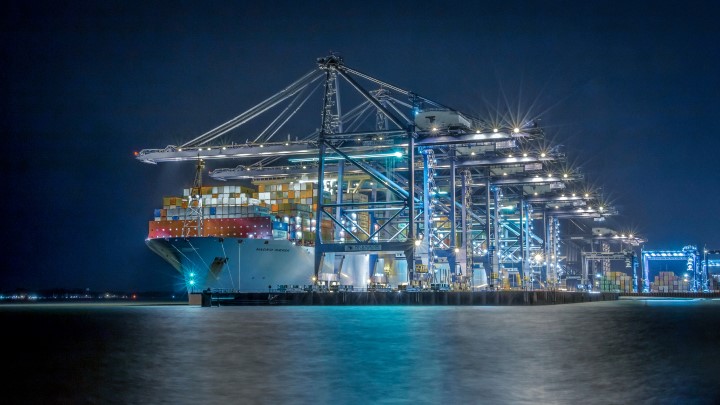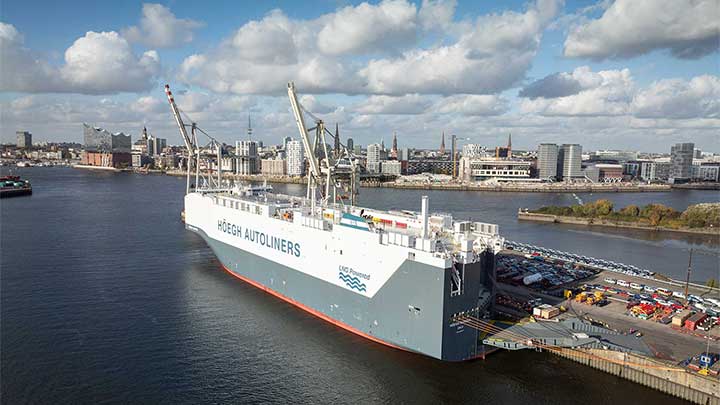Three experts reveal how the shipping industry can use e-Fuels to face a massive reckoning with the climate crisis.
There’s no way around it. Scale is the issue. The energy requirements for climate-neutral shipping are massive – can the industry scale-up its efforts? Three experts reveal potential pathways and a possible pitfall.
By Oliver Sachgau
Replacing just one percent the world’s shipping fuels with e-Methane won from renewable electricity would save as much carbon dioxide (CO2) emissions as removing 5.7 million gasoline cars from the road. But it would also need almost 59,000 gigawatt-hours of renewable electricity to produce, which would be the annual production of around half of the 11,198 wind turbines currently installed in the United Kingdom.
The massive transformations the maritime energy transition needs to succeed require radically scaling up the production of synethetic fuels as viable alternatives to fossil fuels. So where does the industry need to begin?

First commissioned in 2013, the e-Methane plant in Werlte, Germany, is with a capacity of 6 megawatt still the largest in Europe, producing e-Methane for mobility and shipping.
Increasing renewable energy capacity
“It starts with continuing to expand our renewable energies,” explains Volker Quaschning, Professor for Regenerative Energy Systems at the University of Applied Sciences HTW Berlin. “Because the amount of energy we need to meet demand is simply too large to achieve with a handful of wind turbines.”
Renewable energy is a key resource in producing carbon-neutral fuels. Using Power-to-X technology, it can be converted into carbon-free green hydrogen and later stored for long periods of time or further converted into other synethetic fuels – or e-Fuels – such as e-Methanol, e-Ammonia or even e-Kerosene.
Of course, getting more renewable energy into the grid is one thing, but converting it to climate-neutral fuels is another and requires investments in gigawatt-scale electrolyzer plants. These plants use renewable energy in a process called electrolysis that separates water into oxygen and green hydrogen. Currently only 213.5 gigawatts of electrolysis capacity are planned worldwide by 2040, but it’s not enough. To supply all of shipping with, for example, e-Methanol, we would need more than 840 gigawatts.
It starts with continuing to expand our renewable energies.
Creating a demand for e-Fuels
“Here we run into the chicken-and-egg problem,” says Johannah Christensen, CEO of the Global Maritime Forum. “To convert more renewable energy into zero-emission fuels, there needs to be more demand for the fuel. Yet ship operators need reliable sources, so demand is also dependent on availability.”
There is a way around this problem, says Christensen, by starting with commitments for long-term contracts. Companies that commit to shipping goods in a carbon-neutral way create momentum for ship operators to source more synthetic fuels or retrofit ships to run on them, which leads to more demand for renewable generation. “I’m looking at this glass half full,” says Christensen, “I really do believe that over the next few years we’ll be seeing more and more of these long-term agreements coming into place and that will become the key factor in unlocking shipping’s switch to zero-emission fuels.”
Ambitious climate targets will pave the way there, but it will be much easier to achieve them with smaller short-term goals.
International cooperation
Getting enough green hydrogen to make any significant emission reductions in shipping will only be possible with international cooperation, Quaschning says. Countries with more sunlight hours are ideal candidates for big solar-powered projects, but this will also require careful planning and negotiation. “Is, for example, Morocco prepared to make 3, 4, 5 percent of its land available for hydrogen production?”
These questions have to be clarified, he adds: “We can’t just say, ‘Well, if there’s a demand, there’ll be a market.” Instead, Quaschning suggests, the industry has to focus on meaningful scaling. Many pilot projects have been announced, but few make sense to scale up and clearer communication is needed.
“We have to make sure that we’re able to provide large quantities of green hydrogen and ensure that the quantities we can’t produce domestically are built up somewhere else,” says Quaschning. “And here we’re talking about a factor of one to three hundred compared to the projects that are currently in the pipeline.
It should be clear that there are unavoidable carbon sources like the cement industry.
Hidden opportunities for hydrogen exporters
“There’s also another huge opportunity here”, says Christopher Hebling, Director of Division Hydrogen Technologies at the Fraunhofer Institute for Solar Energy Systems ISE. Hydrogen production needs water, often desalinated seawater. Countries that put in the infrastructure to desalinate could then use that same water for agriculture. “It becomes not only an increase of GDP over time, but also an increase of agriculture and general prosperity in regions prepared to make these investments,” he says.
Hebling also says that it isn’t just about eliminating CO2 emissions, since it’s crucial in the production of climate-neutral fuels. According to the International Energy Agency (IEA) report on carbon capture, utilization and storage (CCUS), the world needs to add a carbon capture capacity of 40 million tons per year to contribute to green fuel production.“It should be clear that there are unavoidable carbon sources like the cement industry,” says Hebling. “It would be of big help already, if you take the exhaust gases from a cement factory, extract the carbon and produce your green methanol and use it wherever you can, especially in shipping.”
“Eating the elephant in portions”
The benefits of e-Fuels in shipping could be massive: a single 16,000 TEU (twenty-foot equivalent unit) vessel, if converted to e-Methanol, could save as much CO2 as 104,000 gasoline-powered cars per year. Making sure that CO2 is actually saved will require some effort, Quaschning says, since making e-Fuels with CO2 from fossil fuels will not lead to any real savings. “In that case, nothing is gained because the CO2 ends up in the synthetic fuel and then in the air again. We would have to make sure that we use the CO2 in such a way that it’s in a closed cycle.”

Shipping giant A.P. Moller-Maersk has announced to build a fleet of methanol-powered container ships saving the company an approximate one million of CO2-emissions
So far, the shipping industry has been able to stay under the radar of the public eye, according to Christensen, but with increased scrutiny, the sector is quickly waking up to the impact it can have on fighting climate change. “Ambitious climate targets will pave the way there, but it will be much easier to achieve them with smaller short-term goals.”
One innovative option right now is to start with specific trade routes, make those climate-neutral, and expand from there. A current route for shipping iron ore from Australia to Japan, for example, is already doing exactly that. “It’s basically a way of eating the elephant in portions,” she says. “We don’t need to solve everything at once, instead we can start by looking at particular trade routes.”
About the author
Berlin-based journalist Oliver Sachgau is a specialist in energy and finance whose work has appeared in Bloomberg, The Washington Post, Fortune, and The Independent.
Explore more topics
-

Hoegh - LNG-powered car carrier
With its first LNG-powered car carrier, Höegh Autoliners is taking a big step towards its target of net-zero by 2040. The centerpiece of the vessel is a MAN Energy Solutions MAN B&W ME-GI dual-fuel engine.
-

Maersk Halifax Retrofit
The world’s first methanol retrofit of the Very Large Container Vessel Maersk Halifax opens the doors for green fuels.
-

Methanol dual fuel retrofit
Engineers are now testing a retrofit for four-stroke ship engines that will enable ferry and cruise ship operators to meet the growing requirements on emission reduction with green methanol.
MAN Energy Solutions is now Everllence.
We have adopted a new brand name and moved to a new domain: www.everllence.com. This page will also be relocated there shortly. We are working on shifting all pages to www.everllence.com.
